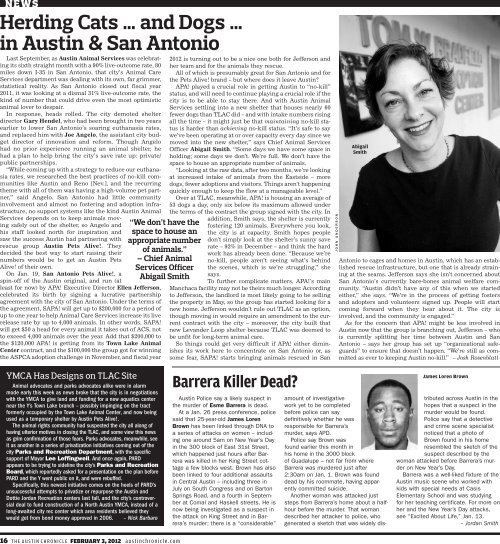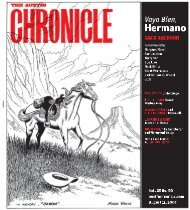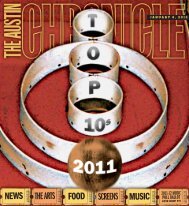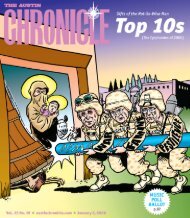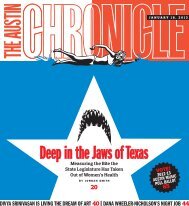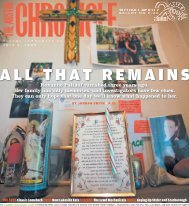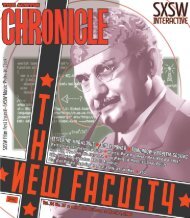Print Edition PDF - The Austin Chronicle
Print Edition PDF - The Austin Chronicle
Print Edition PDF - The Austin Chronicle
Create successful ePaper yourself
Turn your PDF publications into a flip-book with our unique Google optimized e-Paper software.
NEWS<br />
Herding Cats … and Dogs …<br />
in <strong>Austin</strong> & San Antonio<br />
Last September, as <strong>Austin</strong> Animal Ser vices was celebrating<br />
its sixth straight month with a 90% live-outcome rate, 80<br />
miles down I-35 in San Antonio, that city’s Animal Care<br />
Services department was dealing with its own, far grimmer,<br />
statistical reality. As San Antonio closed out fiscal year<br />
2011, it was looking at a dismal 31% live-outcome rate, the<br />
kind of number that could drive even the most optimistic<br />
animal lover to despair.<br />
In response, heads rolled. <strong>The</strong> city demoted shelter<br />
director Gary Hendel, who had been brought in two years<br />
earlier to lower San Antonio’s soaring euthanasia rates,<br />
and replaced him with Joe Angelo, the assistant city budget<br />
director of innovation and reform. Though Angelo<br />
had no prior experience running an animal shelter, he<br />
had a plan to help bring the city’s save rate up: private/<br />
public partnerships.<br />
“While coming up with a strategy to reduce our euthanasia<br />
rates, we researched the best practices of no-kill communities<br />
like <strong>Austin</strong> and Reno [Nev.], and the recurring<br />
theme with all of them was having a high-volume pet partner,”<br />
said Angelo. San Anton io had little community<br />
involvement and almost no fostering and adoption infrastructure,<br />
no support systems like the kind <strong>Austin</strong> Animal<br />
Services depends on to keep animals moving<br />
safely out of the shelter, so Angelo and<br />
his staff looked north for inspiration and<br />
saw the success <strong>Austin</strong> had partnering with<br />
rescue group <strong>Austin</strong> Pets Alive!. <strong>The</strong>y<br />
decided the best way to start raising their<br />
numbers would be to get an <strong>Austin</strong> Pets<br />
Alive! of their own.<br />
On Jan. 19, San Antonio Pets Alive!, a<br />
spin-off of the <strong>Austin</strong> original, and run (at<br />
least for now) by APA! Executive Director Ellen Jefferson,<br />
celebrated its birth by signing a lucrative partnership<br />
agreement with the city of San Antonio. Under the terms of<br />
the agreement, SAPA! will get up to $200,000 for a period of<br />
up to one year to help Animal Care Services increase its live<br />
release rate by up to 4,000 animals. In other words, SAPA!<br />
will get $50 a head for every animal it takes out of ACS, not<br />
to exceed 4,000 animals over the year. Add that $200,000 to<br />
the $120,000 APA! is getting from its Town Lake Animal<br />
Center contract, and the $100,000 the group got for winning<br />
the ASPCA adoption challenge in November, and fiscal year<br />
YMCA Has Designs on TLAC Site<br />
Animal advocates and parks advocates alike were in alarm<br />
mode early this week as news broke that the city is in negotiations<br />
with the YMCA to give land and funding for a new aquatics center<br />
near the Y’s Town Lake branch – possibly impinging on the tract<br />
formerly occupied by the Town Lake Animal Center, and now being<br />
used as a temporary shelter by <strong>Austin</strong> Pets Alive!.<br />
<strong>The</strong> animal rights community had suspected the city all along of<br />
having ulterior motives in closing the TLAC, and some view this news<br />
as grim confirmation of those fears. Parks advocates, meanwhile, see<br />
it as another in a series of privatization initiatives coming out of the<br />
city Parks and Recreation Depart ment, with the specific<br />
support of Mayor Lee Lef fing well. And once again, PARD<br />
appears to be trying to sideline the city’s Parks and Recreation<br />
Board, which reportedly asked for a presentation on the plan before<br />
PARD and the Y went public on it, and were rebuffed.<br />
Specifically, this newest initiative comes on the heels of PARD’s<br />
unsuccessful attempts to privatize or repurpose the <strong>Austin</strong> and<br />
Dottie Jordan Recreation centers last fall, and the city’s controversial<br />
deal to fund construction of a North <strong>Austin</strong> YMCA, instead of a<br />
long-awaited city rec center which area residents believed they<br />
would get from bond money approved in 2006. – Nick Barbaro<br />
“We don’t have the<br />
space to house an<br />
appropriate number<br />
of animals.”<br />
– Chief Animal<br />
Services Officer<br />
Abigail Smith<br />
16 T H E A U S T I N C H R O N I C L E FEBRUARY 3, 2012 a u s t i n c h r o n i c l e . c o m<br />
2012 is turning out to be a nice one both for Jefferson and<br />
her team and for the animals they rescue.<br />
All of which is presumably great for San Antonio and for<br />
the Pets Alive! brand – but where does it leave <strong>Austin</strong>?<br />
APA! played a crucial role in getting <strong>Austin</strong> to “no-kill”<br />
status, and will need to continue playing a crucial role if the<br />
city is to be able to stay there. And with <strong>Austin</strong> Animal<br />
Services settling into a new shelter that houses nearly 60<br />
fewer dogs than TLAC did – and with intake numbers rising<br />
all the time – it might just be that maintaining no-kill status<br />
is harder than achieving no-kill status. “It’s safe to say<br />
we’ve been operating at or over capacity every day since we<br />
moved into the new shelter,” says Chief Animal Services<br />
Officer Abigail Smith. “Some days we have some space in<br />
holding; some days we don’t. We’re full. We don’t have the<br />
space to house an appropriate number of animals.<br />
“Looking at the raw data, after two months, we’re looking<br />
at increased intake of animals from the Eastside – more<br />
dogs, fewer adoptions and visitors. Things aren’t happening<br />
quickly enough to keep the flow at a manageable level.”<br />
Over at TLAC, meanwhile, APA! is housing an average of<br />
53 dogs a day, only six below its maximum allowed under<br />
the terms of the contract the group signed with the city. In<br />
addition, Smith says, the shelter is currently<br />
fostering 120 animals. Every where you look,<br />
the city is at capacity. Smith hopes people<br />
don’t simply look at the shelter’s sunny save<br />
rate – 92% in December – and think the hard<br />
work has already been done. “Because we’re<br />
no-kill, people aren’t seeing what’s behind<br />
the scenes, which is we’re struggling,” she<br />
says.<br />
To further complicate matters, APA!’s main<br />
Manchaca facility may not be theirs much longer. According<br />
to Jefferson, the landlord is most likely going to be selling<br />
the property in May, so the group has started looking for a<br />
new home. Jefferson wouldn’t rule out TLAC as an option,<br />
though moving in would require an amendment to the current<br />
contract with the city – moreover, the city built that<br />
new Levander Loop shelter because TLAC was deemed to<br />
be unfit for long-term animal care.<br />
So things could get very difficult if APA! either diminishes<br />
its work here to concentrate on San Antonio or, as<br />
some fear, SAPA! starts bringing animals rescued in San<br />
Barrera Killer Dead?<br />
<strong>Austin</strong> Police say a likely suspect in<br />
the murder of Esme Barrera is dead.<br />
At a Jan. 26 press conference, police<br />
said that 25-year-old James Loren<br />
Brown has been linked through DNA to<br />
a series of attacks on women – including<br />
one around 5am on New Year’s Day<br />
in the 300 block of East 31st Street,<br />
which happened just hours after Barrera<br />
was killed in her King Street cottage<br />
a few blocks west. Brown has also<br />
been linked to four additional assaults<br />
in Central <strong>Austin</strong> – including three in<br />
July on South Congress and on Barton<br />
Springs Road, and a fourth in September<br />
at Comal and Haskell streets. He is<br />
now being investigated as a suspect in<br />
the attack on King Street and in Barrera’s<br />
murder; there is a “considerable”<br />
J O H N A N D E R S O N<br />
Abigail<br />
Smith<br />
amount of investigative<br />
work yet to be completed<br />
before police can say<br />
definitively whether he was<br />
responsible for Barrera’s<br />
murder, says APD.<br />
Police say Brown was<br />
found earlier this month in<br />
his home in the 3000 block<br />
of Guadalupe – not far from where<br />
Barrera was murdered just after<br />
2:30am on Jan. 1. Brown was found<br />
dead by his roommate, having apparently<br />
committed suicide.<br />
Another woman was attacked just<br />
steps from Barrera’s home about a halfhour<br />
before the murder. That woman<br />
described her attacker to police, who<br />
generated a sketch that was widely dis-<br />
Antonio to cages and homes in <strong>Austin</strong>, which has an established<br />
rescue infrastructure, but one that is already straining<br />
at the seams. Jefferson says she isn’t concerned about<br />
San Antonio’s currently bare-bones animal welfare community.<br />
“<strong>Austin</strong> didn’t have any of this when we started<br />
either,” she says. “We’re in the process of getting fosters<br />
and adopters and volunteers signed up. People will start<br />
coming forward when they hear about it. <strong>The</strong> city is<br />
involved, and the community is engaged.”<br />
As for the concern that APA! might be less involved in<br />
<strong>Austin</strong> now that the group is branching out, Jefferson – who<br />
is currently splitting her time between <strong>Austin</strong> and San<br />
Antonio – says her group has set up “organizational safeguards”<br />
to ensure that doesn’t happen. “We’re still as committed<br />
as ever to keeping <strong>Austin</strong> no-kill.” – Josh Rosenblatt<br />
James Loren Brown<br />
tributed across <strong>Austin</strong> in the<br />
hopes that a suspect in the<br />
murder would be found.<br />
Police say that a detective<br />
and crime scene specialist<br />
noticed that a photo of<br />
Brown found in his home<br />
resembled the sketch of the<br />
suspect described by the<br />
woman attacked before Barrera’s murder<br />
on New Year’s Day.<br />
Barrera was a well-liked fixture of the<br />
<strong>Austin</strong> music scene who worked with<br />
kids with special needs at Casis<br />
Elementary School and was studying<br />
for her teaching certificate. For more on<br />
her and the New Year’s Day attacks,<br />
see “Excited About Life,” Jan. 13.<br />
– Jordan Smith


